Professional Workflow Tips And Guidelines For Web Designers
This overview features a hand-picked and organized selection of the most useful and popular Smashing Magazine’s articles related to the designer’s professional workflow and organization and published here over all the years.
Quick Overview
- The Art Of Staying Up To Date
- Work, Life And Side Projects
- The Process of Creativity
How Do You Deal With Overstressed, Irrational Clients? An Entrepreneur’s View
Lessons Learned: Productivity Tips For Running A Web Design Business
Blogging For Web Designers: Editorial Calendars and Style Guides
The Art Of Staying Up To Date
An important part of our job is staying up to date. Technologies don’t really change that fast — HTML5 and CSS3 take a long time to be specified and implemented. But the ideas surrounding these technologies and the things we can do with them are constantly evolving, and hundreds of blog posts and articles are published every day. There’s no way you can read all of those but you’ll still have to keep up to date. Here are some tips on doing that while still having some time left to work.

Work, Life And Side Projects
There is no doubt about it, I am a hypocrite. Fortunately nobody has noticed… until now. Here’s the thing. On one hand I talk about the importance of having a good work/life balance, and yet on the other I prefer to hire people who do personal projects in their spare time.
Do you see the problem with this scenario? How can one person possibly juggle work, life and the odd side project? It would appear there just aren’t enough hours in the day. Being the arrogant and stubborn individual I am, when this hypocrisy was pointed out to me, my immediate reaction was to endeavour to justify my position. A less opinionated individual would probably have selected one or the other, but I propose these two supposedly contradictory viewpoints can sit harmoniously together.

To understand how this is possible we must first establish why a work/life balance is important and what role side projects play. Let’s begin by asking ourselves why it is important to have a life beyond our computers, even when we love what we do.
The Process Of Creativity
The creative attribute has always been a highly debated and researched component of the human psyche. The “designer” job title seems to be one that calls to the more creative minded among us and according to some, requires the highest level of creative processing. This idea does lend itself to the truth, web designers are called upon to find creative solutions every day. However, we certainly aren’t alone.
Contrary to previous belief, creativity does not limit itself to the “right-brained” artistic types. The ability to find creative and innovative solutions to problems holds value in almost all aspects of life. Even those with highly analytical jobs and hobbies benefit from the ability to approach a complex issue from different perspectives and foresee alternate outcomes. So perhaps it shouldn’t come as much of a surprise to suggest that creativity itself is more rooted in a process than random visionary moments.
In one way or another we have all experienced that classic “aha” moment. Be it in our own experience or through those genius minds we love to follow in shows, movies or books, the light bulb moment of mental clarity is an iconic expression. But whether you know it or not you may be reaching those light bulb moments through more of a defined process than you think.
Don’t Forget The Small Stuff This Year
Whether a designer, developer, blogger, or freelancer, you surely have a to-do list on which certain items slowly inch their way down. These forgotten items add up fast! Think of all the items that you’ve discarded from your to-do list to save time. Even more frightening, what items might you have overlooked to meet a deadline? What have you left on the proverbial cutting-room floor yet again?

What better time than the new year, or new decade for that matter, to tackle your neglected checklist? In this article, we’ll look at some commonly overlooked items on a typical checklist (in no particular order). Some are new, some are commonsense and some are not so minor and ought never to be forgotten. So, let’s get started in this young year by striking off some items from your to-do list!
Web Designer, Be Your Best Promoter
Have you ever had someone flirt with you and they did nothing but demean themselves the whole time? Did that make you attracted to them? Doubtful. Yet, this is how so many individuals seem to handle their business today.
With the advent of social media, the Web has been overflooded with individuals claiming that they are experts at everything. It has become so rampant that whenever I come to see someone label themselves as an expert, I immediately believe they are trying to pull a fast one on me. Unfortunately, many times these people get business because there are people out there who really do believe that they are experts.

How many great designers do you know out there who struggle to find clients, while the world’s worst Microsoft Frontpage jockey can’t keep client offers out of his inbox? I know some of you reading this are dying to get more clients or more users to the app you created. Obviously, to get more people you need to let more people know about you and that doesn’t happen unless you say something. Once you develop a big enough reputation, you can sit back and let others talk about you, but 98% of us aren’t at that point yet so we have only ourselves to depend on.
Conversation Techniques For Designers
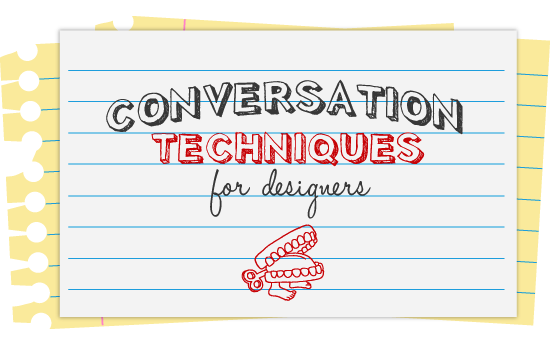
Designers are visually literate creatures. We use visuals to express our ideas, whether by building wireframes, sketching interfaces or pushing pixels. As a result, the majority of knowledge captured when we design a product is some form of “corporate memory”: a combination of assets and documentation. This creation of visual artifact is widely regarded as our most effective means of communicating thought through a product. However, creating a product takes more than just documentation, and much of it is communicated not visually, but verbally.
Product design and development is a combination of creativity and analysis. But it depends on communication. – Michael Bremer
Email Is (Still) Important And Here Is Why Important And Here Is Why”)
Social media is more than a buzzword. It’s now a lifestyle decision for a lot of companies. Many individuals and organizations have abandoned a traditional Web presence (which used to mean a website and email address) in favor of a Facebook page coupled with a Twitter account.

So, where does this leave email? Has the @ symbol lost its meaning as an address, and instead become the signifier of a Twitter name? I think that we need to radically reconsider our approach to email in this changing landscape and understand that it can be a powerful tool when leveraged correctly.
The Art And Science Of The Email Signature
Email signatures are so easy to do well, that it’s really a shame how often they’re done poorly. Many people want their signature to reflect their personality, provide pertinent information and more, but they can easily go overboard. Why are email signatures important? They may be boring and the last item on your list of things to get right, but they affect the tone of every email you write.
Email signatures contain alternative contact details, pertinent job titles and company names, which help the recipient get in touch when emails are not responded to. Sometimes, they give the recipient an idea of who wrote the email in case it has been a while since they have been in touch. They are also professional: like a letterhead, they show that you run a business (in some countries, you’re required to do so). Here are some tips on how to create a tasteful signature that works.
Business Card Design: Better Than A Plain Ol’ Business Card
Going to web conferences is a great opportunity to make new contacts and exchange business cards. Unfortunately, we have an industry filled with creative people who have no creative marketing for themselves. Sure, many have business cards, but one in a hundred have something really cool. These unique treasures, cards, items etc. get kept, talked about and usually photographed and shared. This post is an inspiration for all you creatives to step up your game, either by getting things made or by making them yourselves.

A note of warning though: interesting promotional materials almost always cost more per unit than a white business card or require a lot of prep work, so you’re often going to have a limited quantity. Pick the people you give these treasures to wisely. Those people will feel more important for getting a limited edition, and you don’t run the risk of spending an absolute fortune (in time or money) producing mass quantities!
What Makes A Great Cover Letter, According To Companies?
Ah, the dreaded cover letter. Boring to write, difficult to get right, and you’re usually preoccupied by other things (such as the portfolio and resume, which are also really important). Unfortunately, your cover letter is a company’s first exposure to you, and it determines whether your application is trashed or fast-tracked to the company’s to-hire list.

The status of the cover letter is changing in the Web industry. While a well-formed cover letter still has a place, some companies believe that Web folk who rely on this archaic tool never make it to the next round. But what do I know? Let’s hear instead from some great Web and design agencies to get their advice on creating a great cover letter!
How To Create A Great Web Design CV and Résumé?
The economy is bad. No one’s job is really 100% safe, so it’s time we all bucked up and got our recession bags packed (just in case!). Your portfolio is already gorgeous, but have you created a drool-worthy resume?
This flimsy one-page document is more important than many people think: the resume is the first portfolio piece that potential employers see, and if they’re not impressed, chances are they won’t look at the rest of your portfolio. “But I’m not a print designer!” you moan. It doesn’t matter, and I don’t want to hear your excuses! You need to conquer this, because if you’re a great Web designer, you don’t want your first impression to be mediocre.
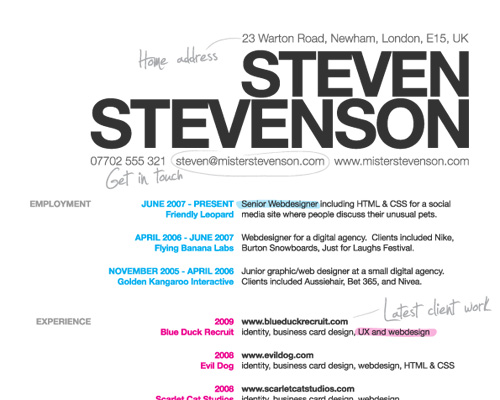
Everyone likes a competition. How about one in which ten good Web designers have to design the same resume in only a few hours? Meet Steven Stevenson, a fictional Web designer, doesn’t have a resume. Rules: each designer must translate his work experience, education and interests into their own unique style. Watch and learn, people. At the end is a summary of good tips for Web designer resumes. (If you’re interested in taking the challenge yourself, check out misterstevenson.com for all the rules these designers followed, Steven Stevenson’s raw data and the chance to add your own entry.)
How To Deliver Exceptional Client Service
We often hear companies, including Web agencies, boast about how they provide exceptional client service. But how do they define exceptional?
Consider this scenario. You are hired to design and develop a new website for a retail client. The client loves the design, and the pages you develop use the latest in HTML5, CSS3 and responsive design, resulting in a website that works wonderfully across browsers and devices. The e-commerce features of the new website help the client significantly increase their online sales, and the entire project is delivered on time and on budget. Now, is this “exceptional” client service? I don’t think it is.

When the client hired you, they expected that you would design and develop a great website. They also expected it would be done according to the timeline and budget set during the planning stages of the project. As successful as this project may have been for both you and the client, in the end, you did exactly what you were hired to do. You did your job.
How Do You Deal With Overstressed, Irrational Clients? An Entrepreneur’s View
As an entrepreneur who has been on the client’s side of the design and development process, I’d like to discuss the thought process of the client, as well as some effective ways to interact with them. For example, why do they ask for Shakira music on the home page? And how do you respond to that?
I was recently referred to Sam Barnes’ piece on Smashing Magazine “How to Explain to Clients That They Are Wrong.” The article was well written and made a lot of sense to me, but there are two sides to every story, and I’d like to add value to the argument by responding from the client’s point of view.

For the most part, Sam did a great job of discussing how to evaluate and act on poor decisions made by clients. What he missed, however, was the impact that the nature of the relationship between clients and creatives has on how decisions are made by both sides. By “creatives,” I mean anyone involved in the design or development of a website or application. Understanding this relationship will enable you, and your clients, to make better decisions about the product.
“But The Client Wants IE 6 Support!”
Frequently, when I discuss CSS3 with other developers, the issue of stubborn clients comes up. They tell me that even though they personally don’t think a website should look the same in all browsers and they’re eager to try all of these new techniques, their clients insist that their website should look the same, so the developers are stuck with the same Web development techniques that we used five to ten years ago. Their clients just don’t “get” graceful degradation.
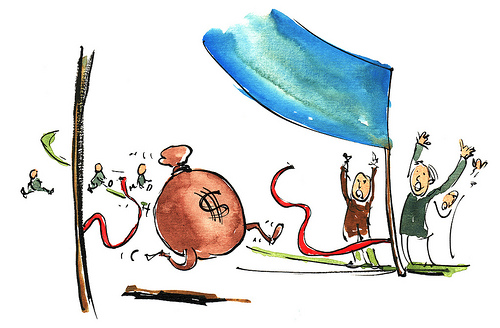
Is this really the issue? Are our clients incapable of understanding these things? Is the problem that our clients don’t “get” the Web and need to be educated? I don’t think so. We got ourselves into this. We are the ones who caused this problem for our industry. We are the ones giving ourselves this trouble and making our profession less creative and enjoyable than it could be. It’s entirely our fault and no one else’s.
Invoice Like A Pro: Examples and Best Practices
Your invoice should be prim and proper, so that you can get paid by your clients efficiently. While invoicing is not a fun task, it’s a necessary one: by keeping clients informed of your expectations, you will get paid punctually and reinforce your professionalism. After going over some best practices for creating invoices, we’ll review some great (and not so great) online invoicing tools, so that you can spend less time creating invoices and more time doing the things you love!
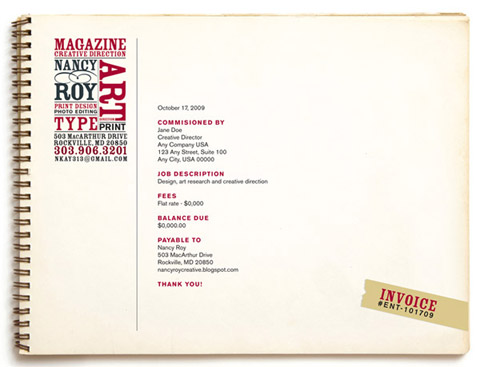
Their details and yours. This is Mickey Mouse stuff, but you can’t afford to forget it. In addition to the client’s address, make sure to include the name of the client’s contact person who handles your account! A company with three employees can figure out what you’re doing; but in big companies, invoices get misplaced, especially if there’s confusion over who belongs to which project.
Five And A Half Habits Of Highly Effective Designers
We have theories about everything: why the sky is blue, why apples fall, why bees buzz (and do other unmentionable things), why my boss said a certain thing, why that girl in the restaurant looked at me, why didn’t that girl in the restaurant look at me…. We’re wired to theorize. Theories make us feel secure. We can wrap our heads around them and explain them with little diagrams on whiteboards, or with equations, or even graphs. We give theories fancy names like “The Classical Elemental Theory” and “The Flat Earth Hypothesis.”

The bottom line is: we humans love theories. Yet as a wise person once said, “In theory, theory and practice are the same. In practice, they are not.” This article is about practice. It’s about five and a half — yes, half — habits that highly effective designers tend to share and which I’ve observed first-hand in the complicated, non-theoretical, absolutely real world. If practice is your thing, keep reading.
Lessons Learned: Productivity Tips For Running A Web Design Business
It didn’t work out as you expected, did it? The freelance life was supposed to give you more time with the family and free you from that incompetent boss. You even thought you might be better off financially. Instead, you’re working longer hours and under constant stress, worrying about various aspects of your business.
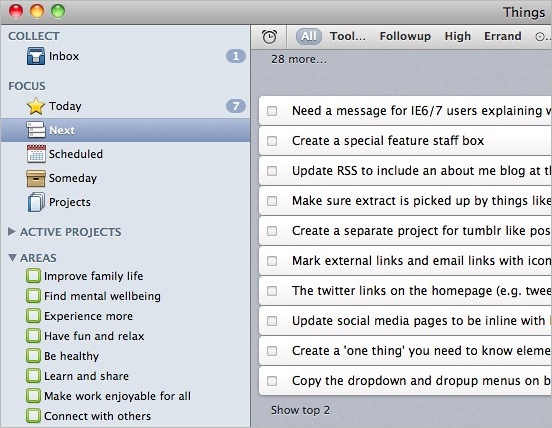
To relieve the pressure of entrepreneurial life and avoid burning out, freelancers and business owners need strategies. In this post, I’ll share some tactics that have helped me be more in control of my business, my projects and life in general. I hope they help you, too.
Let’s begin by putting some solid plans in place.
9 Steps To A Happy Relationship With Your Hosting Provider
Having a good relationship with your hosting provider is perhaps not crucial, but pretty darn close to it if you want to maintain a fully functional website. Remember that even though you are the client, you still need to abide by the beloved ToC (Terms and Conditions) of your hosting provider. You should also research hosting plans to prevent future quagmires. Listed below are ten points to think about before signing up with a Web host and what to do if you already have a provider.

One of the best and easiest ways to maintain a happy relationship with your hosting provider is to not go blind staring at the price tag. We know it’s easy to do, but remember that in most cases you get what you pay for. Cheap Web hosting can, of course, be top-quality and sufficient for small websites, but it can also be really poor and get you off to a bad start with your new host. Make sure you look at what features are included in the hosting package.
Five Copywriting Errors That Can Ruin A Company’s Website
No matter how brilliant a website’s design, no matter how elegant its navigation, sooner or later visitors will decide whether to take action because of something they read. In the end, the effectiveness with which a website converts visitors hinges on words. If a new website is going to hit all the right notes, its content must be just as well crafted as its design and programming.

However, as you might imagine, there are many ways to go wrong with content in a Web development project. The errors discussed in this article have the potential to undo a website and are issues that I run up against time and time again in my nearly 12 years of producing Web content. Half the battle in avoiding these traps is simply recognizing them: all too often, content is handled as an afterthought, hurriedly completed to meet a project’s deadline.
Content Strategy: Optimizing Your Efforts For Success
Content strategy is a beast with many heads, names and trajectories. To approach it is to be sucked in full force. Even so, as crucial as content strategy is, conveying its gravity to a big audience, or to key administrators, is often hard. Being so inherently complex, it’s often easiest to tackle by example.

My first job as a Web content writer involved creating a campaign that promoted holiday spending and travel. I came up with clever tag lines that incorporated lyrics from Bing Crosby Christmas jingles. I thought I was doing great work, and when I got an email from my boss to discuss the campaign, I assumed I would get a pat on the back.
Blogging For Web Designers: Editorial Calendars And Style Guides
A few years ago, you might not have pointed out during a meeting with a potential client that you maintained a blog. Over time, though, blogs have evolved from the being a personal hobby to a serious work tool. In fact, today, web designers are supposed to know much more than just how to design and build websites. Customer’s expectations have increased, and unless you are in position to choose your favourite clients, meeting them requires hard work.

Hence, it’s important to keep learning about the variety of design-related fields every single day — be it marketing, psychology, business, copywriting, publishing or blogging. This article doesn’t cover “traditional” web design discipline as we know it, but goes a bit beyond it, exploring various writing, blogging and online publishing strategies. Apart from that, we present some useful writing style guides that may help you educate your clients on their copy for their upcoming project.
Related Posts
You might be interested in the following “Best of” selections as well:
- Useful Business Advice And Tips For Web Designers
- Usability & User Experience
- Time Savers, Tools And Useful Services For Web Designers








